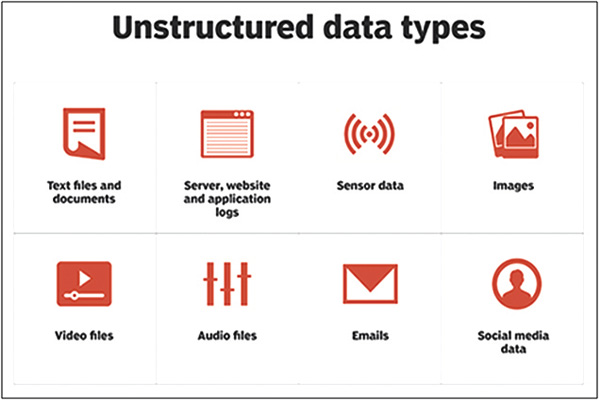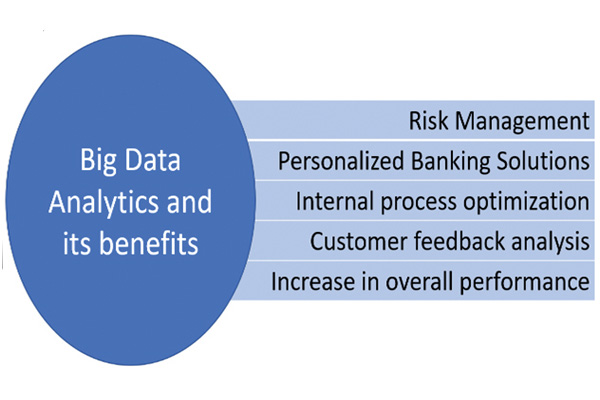Big data analytics is a multifaceted process of examining a large chunk of data to revealinformation such as data correlations, hidden patterns, market trends and preferences of consumers which help organisations make informed business decisions. It is a type of advanced analytics, involving composite applications with important elements such as predictive models, statistical algorithms and what-if analysis powered by analytics systems. Some of its major sources areonline platforms (social media, media publishing outlets, blogs, etc.), data collected by user devices (computers and mobile gadgets), corporate assets (archives, databases, etc.) and search inputs.
History of big data analytics and its role in Banking
The word Big Data was first time referred in mid-1990s to large data volumes. In 2001, Doug Laney, an analyst working at consultancy Meta Group Inc. expanded big data definition as increased volume, variety and velocity of data generated and used by organisations. In year 2006, Hadoop a distributed processing frameworkwas launched. This established the clustered platform built on base of commodity hardware and one which can run big data applications.
By 2011, Big Data Analytics began to be found in almost allthe large internet and e-commerce companies like Yahoo, Google, and Facebook and with all the analytics
and marketing services providers. But more recently, a wider variety of users likeretailers, financial services firms, insurers, healthcare organisations etc. have started using big data analytics as a key technology driving digital transformation.
With the development of digital technology, data has become crucial, and banks are working hard to adapt to thesesudden changes. The scale of competition is significantly high in the industry, and new methodsmust be adopted to survive and thrive in the competitive market environment so that the business grows with success.
Big data analytics have allowed banks to improve the standards and the quality of services they provide to their clients. Therefore, it is no big deal that the banking sector is making a huge investment in big data and its technologies. Another important role of big data can be understood through the fact that a large amount of data is getting generated and handled by banks and financial institutions, but Big Data Analytics help banks and financial services to efficiently store data, analyse it and improve scalability.
Process of Big Data Analytics
The four steps of the big data analytics process are:
1. Collection of data: Data professionals collect a miX of semi-structured and unstructured data from varied sources usingdifferent data streams, like internet clickstream data, web server logs, cloud data, mobile applications, social media content, survey responses, mobile phone records etc.
2. Processing of data: After data is collected and stored in a data warehouse or data lake, data professionals organise, configure and partition the data properly for analytical queries. Analytical queries need detailed data preparation and processing which deliver higher performance.
3. Cleansing of data: Data professionals clean the data using scripting tools or data quality software. They check for errors or inconsistencies in data, such as redundancy or formatting mistakes, and finally classify and tidy up the data.
4. Analysing the data: The clean data is analysed with analytics software. This includes tools fordata mining(searching patterns and relationships through data sets), predictive analytics (models to forecast customer behaviour), machine learning(algorithms to analyse large data sets), text mining and statistical analysis software and data visualisation tools.
Big data analytics uses and examples
Big data analytics can be used to help companies in many ways. Some of them are:
● Targeted ads: Data personalisation and analytics from sources such as previous purchases, interaction patterns and history data of product page views help generate compelling targeted ad campaigns for customers.
● Customer acquirement and retention: Customer data analytics helps incompanies’ marketing efforts by determining the trends to increase customer satisfaction. For example, firms like Amazon, Netflix etc.have provided personalised pages to improve customer experiences.
● Development of final product: Big data analytics provide proper insights to notify product feasibility, development decisions, progress measurement, and
drive improvements in the product as per customer’s needs.
● Price optimisation: Retailers may opt for pricing models that use and model data from a variety of data sources to maximise revenues.
● Supply chain and channel analytics: Predictive analytical models can help with pre-emptive replenishment, B2B supplier networks, inventory management, route optimisations, and the notification of potential delays to deliveries.
● Risk management: Big data analytics help identify new risks from data patterns for effective risk management strategies.
● Improved decision-making: The insights extracted from theappropriate data can help companies make quicker and better decisions.
Growth, trends and forecasts of Big Data Analytics in Banking Market
With the advent of COVID-19, financial markets have made losses up to USD 744 billion by March 20201. Investors had been wary of putting their money in the market andbanks are having tough time to maintain good assets and earnings. There had been
multiple business shutdowns in various regions which have made banks almost dry, and it can prove to be a deterrent for banks to invest in Big Data Analytics. Still, it is estimated Big Data Analytics in the Banking market is expected to register a CAGR of 22.97 per cent by 2027.
The latest trends and drivers for adoption of Big Data Analytics include:
● Significant growth in the amount of data generated by banks and this swift growth requires better acquisition, organisation, integration, and analysis.
● The number of devices that clients use to initiate transactions is also increasing which further increases the number of transactions. Big Data analytics offers a single place for data analysts to view and easily find all data points, which enables
the team to share insights and improve the banking sector.
● Big Data solutions allow a company to store its data in a cost-effective and flexible environment and help in delivering the processing, persistence, and analytic capabilities required to discover new business insights.
● Big Data Analytics stores and curates structured and unstructured data.
● BFSI industry has embraced cloud deployment of data due to an increase in digital disruptions and technological advances like edge computing, the internet of things (IoT), and artificial intelligence. Moreover, COVID-19 caused a rush in cloud deployment of data in the BFSI market due to increased demand for greater computing power among banks and the fintech sector.
● It is estimated that by 2022, more than 3/4th adult population of the world will have bank accounts up from 51 per cent in 2011.
● Big data analytics adoption in the banking market is assisted by the rising number of digital users. For instance, Bank of America added over 2 million active digital clients in year 20211.
● The pandemic has also brought in the importance of personalisation and customer experience. With the shift to smartphones, more than 89 per cent of clients globally prefer mobile banking channels, and therefore digital-only institutions outperformed traditional banks. Fintech firms gained the most.
Advantages of Big Data in Banking
Big data brings several benefits to banks. Some of them are mentioned below:
● Risk Management–
Banks use Big Data Analytics to analyse market trends and customer data records and make decisions like:
A. decide on interest rates
B. identify customers with unsatisfactory credit scores to avoid offering loans to them
C. detect frauds and prevent potentially malicious activities.
1 – According to research conducted by the research firm Mordor Intelligence
● Personalised banking solutions– Banks use Big Data Analytics to detect customer behaviour based on the inputs received from their investment, shopping trends, or financial background. Banks can find ways to retain customers with personalised solutions and attract many more.
● Internal process optimisation and streamlining– Banks can achieve this using big data analytics and boost their performance and reduce operating costs.
● Customer feedback analysis– Banks’ customer centers are usually overloaded with queries. Big data tools help to scan through large volumes of data and respond to the customers swiftly and adequately by helping create a master database. Customers feel valued by this promptness.
● Overall performance is increased– Big data analytics also helps in assessing the employee’s performance against their targets and suggests ways to scale better.
Big data analytics challenges
Some of the challenges with its use in banking. Some of them are mentioned below:
● The struggle of legacy systems– The banking sector has been slightly slow to remodel. Many banking systems find it difficult to cope with the growing workload. During the process of collecting, storing, and analysing data with outdated infrastructure, there is a risk of de-stability of systems.
● Security concerns– Banks deal with huge amounts of data. Banking service providers are supposed to make sure that the amount of user data they collect, and the process undergone must remain safe.
● Data quality maintenance– With a large amount of data coming in from a variety of sources and in structured and unstructured formats, management of data quality requires significant time, effort, and resources.
● Choosing the right tools– There are a lot of Big Data Analytics tools and platforms available on the market and at times it gets difficult for banks to pick the best tool that aligns with users’ needs and infrastructure.
Conclusion
Big Data Analytics is now being implemented across various spheres of the banking sector and is helping them deliver better services to their customers, both internal and external, along with which it is also helping them improve their active and passive security systems.
Views expressed by Thomas Mathew, Research Officer, State Bank of India
Elets The Banking and Finance Post Magazine has carved out a niche for itself in the crowded market with exclusive & unique content. Get in-depth insights on trend-setting innovations & transformation in the BFSI sector. Best offers for Print + Digital issues! Subscribe here➔ www.eletsonline.com/subscription/























